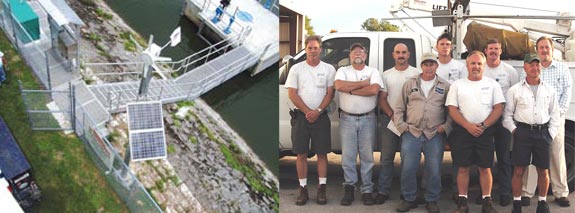 Left: This overhead view shows the wind generator, solar panel and control box of the structure controls at the Medard Dam.
Left: This overhead view shows the wind generator, solar panel and control box of the structure controls at the Medard Dam.
Right: The structure staff operates and maintains the District’s structures, including the structure at the Medard Dam. Back row left to right: Sal Destefano, structure controls senior tradesworker; Dan Pelland structure controls senior tradesworker; Garry Flood, structure controls tradesworker; Robert Sowders, structure Maintenance tradesworker; Jimmy Tuttle, structure maintenance senior tradesworker; Mike Bartlett, structure controls supervisor. Front row left to right: Joe Lang, structure maintenance tradesworker; Danny Brooks structure controls coordinator; and Hugh Asher, structure maintenance tradesworker.
A simple-looking metal box next to a generator and a pole-mounted solar panel and windmill may not appear to be much to the untrained eye, but it is an innovative, environmentally friendly, money-saving part of a system that operates the Medard Reservoir Dam structure.
These components make up the structure control station at the Medard Reservoir, located in eastern Hillsborough County. The District has owned and operated the Medard Reservoir since 1970. The structure on the reservoir is one of the District’s remote-operated structures, which means Mike Bartlett, structures control supervisor, can monitor and operate it anywhere he has access to a phone line or wireless Internet connection via his laptop.
Currently there are 24 remote-operated structures. The District will have 27 that can be operated remotely by December 2007.
A propane generator and the structure controls are located in a fenced area on one side of a gated walkway that employees use to access the structure platform. On the other side, there is a small wind generator and solar panel mounted on a high-grade aluminum pole. The wind generator and solar panel charge two batteries inside the locked control box. These batteries are used to provide a constant power source to the remote controls that signal the propane generator to start, providing power to rise and lower the structure. Once Bartlett sends a signal to raise or lower the structure through a remote line, the machines do all the work.
One of the great things about this control station is that installing the wind generator and solar panel saved the District thousands of dollars.
“The District uses commercial power to run all of our remote structures,” said Bartlett. “But to do that here, we would have had to install a transformer on the berm, running high-voltage cable several thousand feet. This would have required us to cut a 2’ by 4’ deep trench in the berm to bury the cable, possibly compromising the integrity of the berm itself. This option would also have been a great expense.”
That roadblock caused the Structures Control Section to think creatively about ways to power the structure cost-effectively without disturbing the berm, while still maintaining operational reliability.
“Dan Pelland read about the wind generator in a tech magazine,” said Bartlett. “The military uses the same model in the Arctic Circle, so we called Marlec Engineering to find out more about it. I was concerned that it would not withstand our weather, but believe it or not, that thing can withstand winds up to 150 mph.”
The solar power panel also creates energy for the control station. It can be set at three different angles, depending on the season, to make the most of the sun’s energy.
The redesign of the structure control station to use solar and wind power provided constant power to the controls, eliminating the need and cost of installing commercial power. By thinking “outside the box,” the District saved money and built an environmentally friendly control system. District staff custom-built all the surrounding hardware and installed the electrical and computer systems.
In addition to the immediate cost benefit, this structure also is more efficient in times of an emergency, like a hurricane.
“Currently during an emergency, if a structure is on commercial power and it went out, our generator would automatically kick on and run until someone physically came out to shut it off or it ran out of gas,” said Bartlett.
With this new system, the structure control operator will remotely turn the generator on when needed and turn it off when the structure is at the appropriate level, conserving fuel.
“We plan on incorporating the remote start/stop feature into other structure backup generators,” said Bartlett.
Another benefit of this system and control structure is that it is virtually maintenance free and environmentally friendly. The new generator is fueled by propane. If the storage tank were to leak, the propane would evaporate. With a diesel generator, a fuel leak would run down the side of the berm, polluting the water. An added environmental and cost savings is the all-aluminum construction. There is no need to use paint or cleaning solvents to maintain the control structure.
“The simplest things are usually the best,” said Bartlett. “While this structure control station doesn’t look complicated, it saves energy and protects the environment.”
